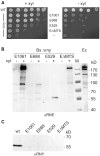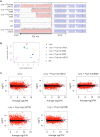Escherichia coli RNase E can efficiently replace RNase Y in Bacillus subtilis
- PMID: 33788929
- PMCID: PMC8096251
- DOI: 10.1093/nar/gkab216
Escherichia coli RNase E can efficiently replace RNase Y in Bacillus subtilis
Abstract
RNase Y and RNase E are disparate endoribonucleases that govern global mRNA turnover/processing in the two evolutionary distant bacteria Bacillus subtilis and Escherichia coli, respectively. The two enzymes share a similar in vitro cleavage specificity and subcellular localization. To evaluate the potential equivalence in biological function between the two enzymes in vivo we analyzed whether and to what extent RNase E is able to replace RNase Y in B. subtilis. Full-length RNase E almost completely restores wild type growth of the rny mutant. This is matched by a surprising reversal of transcript profiles both of individual genes and on a genome-wide scale. The single most important parameter to efficient complementation is the requirement for RNase E to localize to the inner membrane while truncation of the C-terminal sequences corresponding to the degradosome scaffold has only a minor effect. We also compared the in vitro cleavage activity for the major decay initiating ribonucleases Y, E and J and show that no conclusions can be drawn with respect to their activity in vivo. Our data confirm the notion that RNase Y and RNase E have evolved through convergent evolution towards a low specificity endonuclease activity universally important in bacteria.
© The Author(s) 2021. Published by Oxford University Press on behalf of Nucleic Acids Research.
Figures






Similar articles
-
Dynamic Membrane Localization of RNase Y in Bacillus subtilis.mBio. 2020 Feb 18;11(1):e03337-19. doi: 10.1128/mBio.03337-19. mBio. 2020. PMID: 32071272 Free PMC article.
-
In Vitro Study of the Major Bacillus subtilis Ribonucleases Y and J.Methods Enzymol. 2018;612:343-359. doi: 10.1016/bs.mie.2018.08.004. Epub 2018 Aug 31. Methods Enzymol. 2018. PMID: 30502948
-
RNase Y in Bacillus subtilis: a Natively disordered protein that is the functional equivalent of RNase E from Escherichia coli.J Bacteriol. 2011 Oct;193(19):5431-41. doi: 10.1128/JB.05500-11. Epub 2011 Jul 29. J Bacteriol. 2011. PMID: 21803996 Free PMC article.
-
Bacillus subtilis mRNA decay: new parts in the toolkit.Wiley Interdiscip Rev RNA. 2011 May-Jun;2(3):387-94. doi: 10.1002/wrna.66. Epub 2010 Dec 16. Wiley Interdiscip Rev RNA. 2011. PMID: 21957024 Review.
-
RNA degradation in Bacillus subtilis: an interplay of essential endo- and exoribonucleases.Mol Microbiol. 2012 Jun;84(6):1005-17. doi: 10.1111/j.1365-2958.2012.08072.x. Epub 2012 May 8. Mol Microbiol. 2012. PMID: 22568516 Review.
Cited by
-
Quasi-essentiality of RNase Y in Bacillus subtilis is caused by its critical role in the control of mRNA homeostasis.Nucleic Acids Res. 2021 Jul 9;49(12):7088-7102. doi: 10.1093/nar/gkab528. Nucleic Acids Res. 2021. PMID: 34157109 Free PMC article.
-
Recent progress in proteins regulating the germination of Bacillus subtilis spores.J Bacteriol. 2025 Feb 20;207(2):e0028524. doi: 10.1128/jb.00285-24. Epub 2025 Jan 8. J Bacteriol. 2025. PMID: 39772627 Free PMC article. Review.
-
RNase Y mediates posttranscriptional control of the virulence-associated CncR1 small-RNA in Helicobacter pylori.iScience. 2025 Jan 16;28(2):111815. doi: 10.1016/j.isci.2025.111815. eCollection 2025 Feb 21. iScience. 2025. PMID: 39949958 Free PMC article.
-
Membrane Localization of RNase Y Is Important for Global Gene Expression in Bacillus subtilis.Int J Mol Sci. 2024 Aug 5;25(15):8537. doi: 10.3390/ijms25158537. Int J Mol Sci. 2024. PMID: 39126106 Free PMC article.
-
Transcriptome-wide in vivo mapping of cleavage sites for the compact cyanobacterial ribonuclease E reveals insights into its function and substrate recognition.Nucleic Acids Res. 2021 Dec 16;49(22):13075-13091. doi: 10.1093/nar/gkab1161. Nucleic Acids Res. 2021. PMID: 34871439 Free PMC article.
References
-
- Apirion D., Lassar A.B.. A conditional lethal mutant of Escherichia coli which affects processing of ribosomal RNA. J. Biol. Chem. 1978; 253:1738–1742. - PubMed
-
- Ono M., Kuwano M.. A conditional lethal mutation in an E. coli strain with a longer chemical lifetime of messenger RNA. J. Mol. Biol. 1979; 129:343–357. - PubMed
-
- Carpousis A.J., Van Houwe G., Ehretsmann C., Krisch H.M.. Copurification of E. coli RNAse E and PNPase: evidence for a specific association between two enzymes important in mRNA processing and degradaion. Cell. 1994; 76:889–900. - PubMed
-
- Py B., Higgins C.F., Krisch H.M., Carpousis A.J.. A DEAD-box RNA helicase in the Escherichia coli RNA degradosome. Nature. 1996; 381:169–172. - PubMed
Publication types
MeSH terms
Substances
LinkOut - more resources
Full Text Sources
Other Literature Sources
Molecular Biology Databases

